Tsunami Safety Facts
Although advances in science can help predict imminent tsunamis, knowing what to do and when to do it helps you and your loved ones survive and be safe during tsunami emergency. Presence of mind and not ignoring the warning signs are the key to safety. Preparedness also goes a long way.
Here are some safety facts about tsunamis:
- During a tsunami emergency, follow and cooperate emergency tsunami procedures. Stay tuned to local radio and television broadcast.
- The best way to escape a tsunami is on foot and quickly climbing steep slope or tall and strong buildings.
- Under the ocean earthquakes are the leading cause of tsunami. So following one, be vigilant on the sea water and listen to emergency broadcasts.
- If you are in low-lying area after a strong earthquake, keep calm and move quickly to higher ground and away from coastal areas.
- Tsunami can occur at any time of the day. So it's always good to be prepared.
- Tsunani is a series of waves and often times, the first wave is not the strongest. So avoiding the coast after the first wave hits is a good idea.
- Impending tsunami can sometimes cause the sea water to recede - also known as "drawback". So when the sea water recede, especially when it's not time for low tide, following an earthquake, it's time to run to higher grounds.
- Never go down the beach to watch tsunami. Tsunamis can travel between 10 to 20 miles per hour near the shore more than enough to out run anybody even at short distance.
- Buildings in low lying coastal areas are not the safest place to stay during tsunamis.
- Noticeable rise or fall of coastal waters are sometimes sign of approaching tsunami. Pay attention to it espeacially after an earthquake.
- Know the difference between a tsunami warning and tsunami watch.
- The ideal to a spot to survive a tsunami is 100 feet above sea level or 2 miles away from the shore.
- If you can see the wave clearly, you are too close for safety. Move inland, away from the shore and towards higher ground.
- Tsunami waves can continue for hours and the next wave may be more dangerous than the first one. So do not return home unless officials tell you it is safe to do so.
